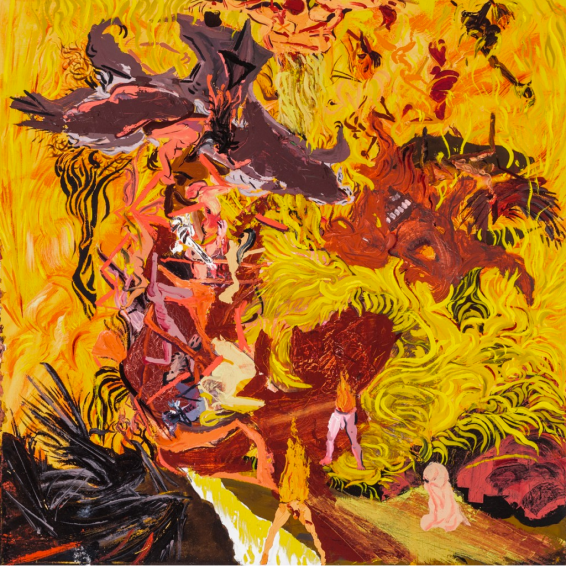Philip Guston’s return to figurative painting was monumental for an artist who came of age with the first generation Abstract Expressionists. He is best known for these disordered figurative paintings of hooded klansmen, cigarette butts, and other cartoonesque objects and symbols, which he began to create in the late 1960s.
Guston is still a major influence on contemporary painterly discourse, and a new exhibition at The Lodge Gallery in the Lower East Side seeks to explore and celebrate Guston’s iconoclastic legacy on today’s contemporary painters. Heathen Fundamentalism, the current exhibition at The Lodge Gallery, features seven contemporary artists who channel elements of Guston’s work to create painterly conversation with him posthumously. Like Guston, each of the seven artists in the exhibition create “impure” painterly imagery, break the mold of aesthetic monotony, and reflect on their cultural environment in a uniquely personal way.
Upon entering the exhibition, the viewer is flanked on both sides by two fairly large canvases (shown below) by Dawn Frasch and Leonard Reibstein. Both painters, whose studios are in Brooklyn, also share a similar panache for expressive paint handling, and rendering of the figure through anarchic compositions. It can be said that both painters have a penchant for the abject, although they’re not interested in shocking or disturbing the viewer for the sake of it. There’s strong underlying humanist themes in their work, as well as a visual vocabulary with the history of both Eastern and Western painting.
Dawn Frasch’s paintings give a personal feminist and LGBTQ perspective of the world. Her paintings are a tour de force of issues around gender and identity. Frasch takes on the female form to address issues of loss, crisis, longing, and fear. Her aggressive yet empowering imagery addresses preconceived gender roles and exposes the cliche dynamics of a machismo society. These compositions are infused with pop cultural references and often presented through the lens of the art historical canon. Frasch is also inspired by Japanese Ukiyo-e masters like Utagawa Kuniyoshi, which comes through in her heroic style.
Reibstein addresses many societal issues that he perceives and struggles with on a personal level. In the largest of his paintings in the show, titled Crowning, Reibstein suggests the complexity of birth and issues such as abortion. There is also his Self Portrait that personifies his self-awareness as a human being, albiet with slightly exaggerated features. Reibstein’s influences range from Old Italian and Dutch Masters to Guston and Bacon to the fantastical imagery of Japanese manga. Like Guston, he is drawn to painting the impurities of flesh. The way he applies color and layers the paint seamlessly blends abstraction and figuration. These images have strong subconscious implications.
The paintings of Paul Brainard, Doug Parry, and Tom Sanford present some of the most literal Guston references. Brainard combines humor with a dose of pop culture, consumerist critique, and overtly sexual themes. His vibrant canvases contain signs and symbols of contemporary culture, from pop songs (like the painting 867-5309) to consumer brands, which express a void of substance in everyday life. These paintings are a condemnation of media culture and the lack of spirituality and essence in today’s society.
Doug Parry’s work is full of good humor and painterly playfulness. However, there is also a very serious and unique introspective element to them. Parry created these paintings to address his own feelings of stress, deflation, and the value of his artwork. In the exhibition, paintings like Incognito (2012), are composed from novelty items (rubber noses, Groucho glasses, etc) in symbolic still lifes that touch on a distinct personal level reflecting particular memories from his life.
Tom Sanford also employs a humorous and lighthearted side to his paintings which often reference pop culture and his own personal circle of art world friends and influences. Similar to Brainard, Sanford captures the 24 hour media saturation of our cultural landscape. The rendering of the sharp hairs on the artist’s legs in the painting Tom and Alex in Bed immediately had me thinking Guston. Sanford also shares a kindred painterly spirit with another seminal modernist painter named Red Grooms.

Laura Moriarty, The Vast Emptiness of Silent Glory,
2015,
Pigmented beeswax, powder charcoal
11 x 10.50 x 4.75 inches
Laura Moriarty creates paintings that are three dimensional. Her paintings are the only non-figurative works in this exhibition, but they work just fine with the theme of Guston. Moriarty builds up her compositions using layers of pigmented beeswax and powdered charcoal. Like Guston, Moriarty takes tremendous risks in her work. There aren’t many encaustic painters who are making 3-D work and using materials in unconventional ways. The results are mesmerizing.
Aaron Johnson is establishing himself nicely as a provocateur in the art world. His burlesque painterly constructs are built up in layers of paint combined with non-traditional mediums and often express political and socially conscious subjects. More recently, Johnson has been collecting socks (from all over the world) to create massive canvases like Hummer (2013), a raucous scene of a female sock creature performing fellatio on a male sock creature.
It is refreshing to see all of these seven artists grouped together. Perhaps, the inclusion of one additional female artist would balance out the representation a bit more. The show got me thinking of other artists that could make for a larger survey of this zeitgeist, and then I found out about The Guston Effect, which is on view at the Steve Zevitas Gallery in Boston. Hopefully there will be more shows examining the influence of other maverick painters -Lester Johnson, Jay Milder, Nancy Spero, June Leaf, and Emilio Cruz to name just a few- who paved the way for a new and exciting generation of painters like the seven in Heathen Fundamentalism, which runs through June 28th.






Pingback: Heathen Fundamentalist ; An Ode To Phillip Guston – June 3- June 28 | Jason Patrick Voegele